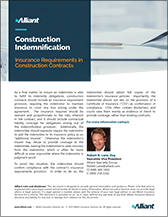
Managing Risks in Construction Projects
The success of a construction project depends on the effective coordination and synchronization of multiple parties. Each of these parties—project owners, architects, engineers, construction managers, general contractors, subcontractors, and suppliers—undertakes a specific set of responsibilities that gives rise to corresponding risks. These risks permeate the construction process and come in various forms, including property damage to the project itself (e.g., faulty design, construction defects), property damage to nearby properties (e.g., chemical spills, fires), bodily and personal injury (e.g., slip and falls, chemical exposure), economic losses (e.g., lost income, financing costs) or professional liability (e.g., negligence, malpractice), among others.
The use of construction contracts to identify and properly allocate risks, typically to the parties with the most control over preventing or avoiding such risks, is imperative not only to the construction project itself, but also to the long-term financial stability of the parties involved. Parties to construction contracts often rely on their trusted advisors, especially their insurance brokers and lawyers, to review these contracts and advise them as to their scope, the exposures they face by signing them, and how their insurance program may (or may not) protect them for those exposures. These contracts can often be confusing, complicated, and full of legalese and with all the potential exposures faced by parties to a construction project, it is imperative that the parties to these contracts enter into them with eyes wide open.
As such, in an effort to simplify some of the indemnification and insurance provisions in construction contracts and to offer the contracting parties and their advisors a guidepost to better understand them, we have prepared an overview on the use of indemnification provisions to manage risks in construction projects, as well as insurance requirement provisions that act as backstops to those provisions to ensure satisfaction of indemnification obligations in the event of a loss.
Read Part One: Indemnification Provisions in Construction Contracts

For More Information, Contact:
Robert N. Lane, Esq.
Executive Vice President, Alliant
Partner, Reed Smith
Partner, Reed Smith
© 2000–2020 Alliant Insurance Services, Inc. All rights reserved.
